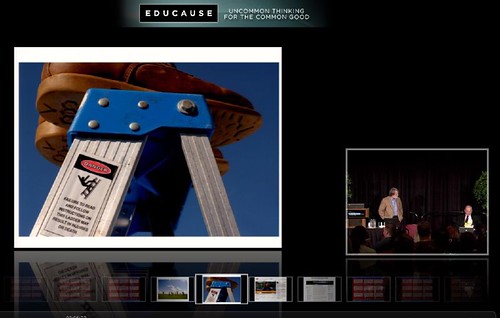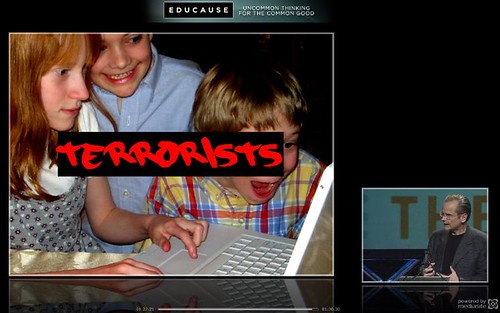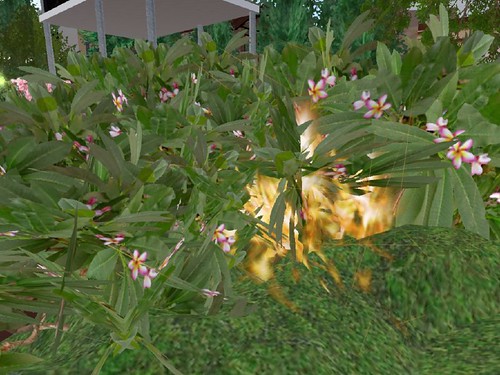In early March, I was honored to be a guest moderator for the Virtual Worlds Educator Roundtable, where I got to interview the folks who make the weekly meetings happen. Â It was a really great session with lots of reflections about how far we’ve come in terms of using virtual worlds for education, and lots of brainstorming about where this field is going.
But one of the questions I asked the panel kind of stuck in my mind and I’ve been thinking about it ever since. Â I asked if the panel had any thoughts about Linden Lab’s new CEO, Rod Humble (SL: Rodvik Linden), and I was surprised to hear several panelists say that they weren’t following the employees of Linden Lab as closely as they had in the past. Â To paraphrase, one of the panelists said something like the “the cult of personality phase” of their watching Linden Lab was over. Â I can appreciate that, after last year’s downsizing at the Lab, many of the employees I knew and had spent years developing good working relationships with were gone, and it seems from the outside as if we’re almost dealing with an entirely new company.
Rod Humble in his office at Linden Lab.  Image courtesy New World Notes.
Still, I thought about the panelists’ responses and wondered if I was perpetually in some kind of fan-girl stage of watching the leadership at the Lab for clues and omens about the future of the platform. Â Having given it some thought, I don’t think so. Â Though I have many criticisms of Second Life as a platform, and of Linden Lab as a company, I still see Second Life as the primary consumer platform in the virtual world space – and as such, I think its leadership matters very much. Â For good or ill, the philosophy of its CEO and other senior management can and will have a direct impact on my work, and potentially impact the direction the metaverse takes as a whole.
In that sense, I think it matters quite a lot what those leaders think, and as I’ve watched Rod Humble’s tweets and interactions with the Second Life userbase over the past few months, I’ve been more and more pleased that Second Life is being headed up by someone who seems to be, above all, thoughtful about what virtual worlds are, what impact games have on human behavior, and what the end goal is of our virtual lives. Â In sharp contrast to the last CEO, who seemed more focused on monetizing and marketing virtual worlds as an economic tool, Humble appears to genuinely reflect on the same kinds of questions that sometimes keep me up at night. Â And I find that comforting.
Humble’s Keynote at Inventing the Future of Games
I was having those thoughts about Humble’s leadership of Second Life (so far) even before I saw his recent keynote at the Inventing the Future of Games conference last week, but after watching the video multiple times, I am even more convinced that the Second Life platform is in better hands.
I should note, the audio quality of this video is not so great (part of the reason I had to watch it over and over) but I’m still grateful for the folks who made it available to those of us who couldn’t attend the conference. Â Â If the audio troubles are too much for you, check out this synopsis on Gamasutra.
Asking the Right Questions
It pleases me to know that Humble is thinking about this stuff on a very deep level, and is asking the kinds of moral and ethical questions that I worry often get pushed aside in the pursuit of  making money for shareholders and investors.
Perhaps more importantly, I think he’s asking some of the right questions. Â He accepts, as I suspect most people reading this blog do, that games and virtual worlds are an art form, and that games and virtual worlds can and do change people’s behavior. Â The real question is – to what purpose? Â And as designers and developers of virtual spaces, are we thinking about this enough?
I think it’s extremely important to look at it and say how can we take responsibility as game creators. What games should we ethically build? If you are going to be influencing those [players] you have an enormous weight on your shoulders.” Â Â – Rod Humble at the Inventing the Future of Games Conference
Like Humble, I too hope to see virtual worlds and game worlds do more to explore the issues of power, class, and freedom – and what it means to be human in this increasingly virtual “real” world.  And I hope that this can be an ongoing dialogue  between the leadership at the Lab and the community of users who have invested in expressing their own visions of the future through the Second Life platform.
All too often in the past, it felt as if the Lab’s goals were simply to capitalize on the work of its Residents instead of recognizing that beyond earning a living, most of us are living out our digital lives in pursuit of answers to the same profound questions that govern our real lives.
Many cheers for a CEO who is engaged as deeply in those questions as we are.









![Reblog this post [with Zemanta]](http://img.zemanta.com/reblog_c.png?x-id=a7a2211b-6d71-449d-9f11-ec694b184655)
